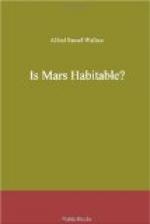[Footnote 13: Nature, vol. 70, p. 536.]
This opinion is especially important because, next to Mr. Lowell, Mr. Pickering is perhaps the astronomer who has given most attention to Mars during the last fifteen years. He was for some time at Flagstaff with Mr. Lowell, and it was he who discovered the oases or craterlets, and who originated the idea that we did not see the ‘canals’ themselves but only the vegetable growth on their borders. He also observed Mars in the Southern Hemisphere at Arequipa; and he has since made an elaborate study of the moon by means of a specially constructed telescope of 135 feet focal length, which produced a direct image on photographic plates nearly 16 inches in diameter.[14]
[Footnote 14: Nature, vol. 70, May 5, p.xi, supplement.]
It is clear therefore that Mr. Lowell’s views as to the artificial nature of the ‘canals’ of Mars are not accepted by an astronomer of equal knowledge and still wider experience. Yet Professor Pickering’s alternative view is more a suggestion than an explanation, because there is no attempt to account for the enormous length and perfect straightness of the lines on Mars, so different from anything that is found either on our earth or on the moon. There must evidently be some great peculiarity of structure or of conditions on Mars to account for these features, and I shall now attempt to point out what this peculiarity is and how it may have arisen.
The Meteoritic Hypothesis.
During the last quarter of a century a considerable change has come over the opinions of astronomers as regards the probable origin of the Solar System. The large amount of knowledge of the stellar universe, and especially of nebulae, of comets and of meteor-streams which we now possess, together with many other phenomena, such as the constitution of Saturn’s rings, the great number and extent of the minor planets, and generally of the vast amount of matter in the form of meteor-rings and meteoric dust in and around our system, have all pointed to a different origin for the planets and their satellites than that formulated by Laplace as the Nebular hypothesis.
It is now seen more clearly than at any earlier period, that most of the planets possess special characteristics which distinguish them from one another, and that such an origin as Laplace suggested—the slow cooling and contraction of one vast sun-mist or nebula, besides presenting inherent difficulties—many think them impossibilities—in itself does not afford an adequate explanation of these peculiarities. Hence has arisen what is termed the Meteoritic theory, which has been ably advocated for many years by Sir Norman Lockyer, and with some unimportant modifications is now becoming widely accepted. Briefly, this theory is, that the planets have been formed by the slow aggregation of solid particles around centres of greatest condensation; but as many of my readers




